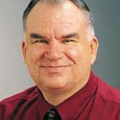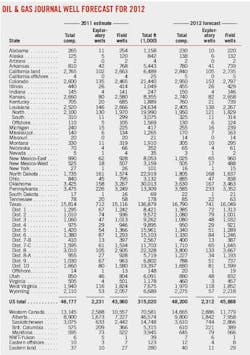Strong drilling year seen in 2012 in US, Canada
Drilling activity should remain strong in the US and Canada in 2012 after substantial year-to-year gains in 2011.
OGJ looks for a 4% increase in total drilling in the US and an 11.5% hike in Canada in 2012.
Operators in the US are for the most part maximizing efforts in plays for oil and wet gas and relaxing capital spending in dry gas areas.
Horizontal drilling and hydraulic fracturing continue to be the primary drivers. Shale plays are at the fore of unconventional activity, while low-permeability plays encompass large areas in Texas, Oklahoma, and other states.
Few companies had announced 2012 capital spending plans by the time of this writing in mid-December 2011.
Here are highlights of OGJ's early year drilling forecast for 2012:
• Operators will drill 48,200 wells in the US, up from an estimated 46,177 wells in 2011.
• All operators will drill 2,313 exploratory wells of all types, up from an estimated 2,231 last year.
• The Baker Hughes Inc. count of active US rotary rigs will average 2,010 rigs/week this year, up from 1,871 in 2011 and 1,515 in 2010.
• Operators will drill 14,665 wells in western Canada, up from an estimated 13,145 wells in 2010.
US drilling trends
Land drilling strength has bolstered overall drilling as Gulf of Mexico activity struggled to recover in 2011 from the moratorium that followed Macondo.
Early December counts indicated 36 rigs working off Louisiana and 4 off Texas compared with 21 and 2, respectively, in late 2010.
West Texas (Dists. 7C, 8, and 8A) had 399 rigs running or 20% of the total US count and up from 282 in December a year earlier, and the Eagle Ford play doubled the South Texas Dist. 1 count to 124.
The Oklahoma rig count gained 31% to 198 rigs in December 2011.
In Alaska, rigs have begun returning to Cook Inlet, and recent lease sale results indicate continued exploratory drilling interest on the North Slope and Brooks Range foothills.
Industry sources report about two dozen rigs active in the Illinois basin, almost all of a type that Baker Hughes doesn't count.
US plays, performance
Drilling footage is growing in the US as operators punch longer laterals in land plays and plumb ultradeep depths in the gulf.
OGJ estimates that operators will exceed 336 million ft of hole in the US in 2012 compared with 315 million ft in 2011. No doubt the current penchant for horizontal holes is saving the drilling of hundreds or thousands of wellbores from surface.
As Shell extended the water depth production record to 9,627 ft at Tobago field, and even though relatively few rigs are running in the gulf, drilling below 30,000 ft has become routine. McMoRan Exploration Co. sought to deepen its Lafitte exploratory well, in 140 ft of water on Eugene Island Block 223, to 32,000 ft, and Chevron bottomed at 31,545 ft at its Moccasin Lower Tertiary Wilcox discovery on Keathley Canyon Block 736.
OGJ sees operators drilling as many as 2,950 wells in 2012 in Colorado, where discoveries in the Niobrara formation are breathing new life into exploratory programs.
Oklahoma horizontal drilling is spearheaded by the liquids-oriented Cana Woodford, Granite Wash, and Mississippian plays. Drilling in the Arkoma basin Woodford and Fayetteville and Louisiana Haynesville gas plays declined.
A Shell Oil Co. affiliate staked its first horizontal and vertical locations in the Mississippian play in Harper and Barber counties, southern Kansas, making Shell the first major oil company in the play and marking the company's first locations as operator of record in Kansas since 1986, IHS Inc. reported.
Bakken drilling is keeping some 188 rigs busy in North Dakota, a 31% increase from late 2010. The Pennsylvania rig count was up 31% year-on-year in 2011.
Canada's outlook
OGJ statistics indicate that Canada produces 3 million b/d of oil and 12 bcfd of gas, but the country commends only 484 active rigs, about 8% more than in late 2010.
The Canadian Association of Petroleum Producers has forecast that 13,000 wells will be drilled in Canada in 2012.
The Petroleum Services Association of Canada forecast that operators will drill 15,100 wells in Canada in 2012, a 10% increase from the 13,700 wells it estimated to have been drilled in 2011.
A growing number of all wells drilled in Canada have horizontal legs, and the lengths of those laterals are getting longer, industry spokesmen said.
Daily Oil Bulletin figures show that 50% of the 5,204 permits issued in January-July 2011 were for horizontal holes, up from 16% in the same period of 2008.
PSAC sees 55% of wells being horizontal in 2012 and horizontal length averaging 5,960 ft, up 50% from 2007.
More Oil & Gas Journal Current Issue Articles
More Oil & Gas Journal Archives Issue Articles
View Oil and Gas Articles on PennEnergy.com
About the Author

Alan Petzet
Chief Editor Exploration
Alan Petzet is Chief Editor-Exploration of Oil & Gas Journal in Houston. He is editor of the Weekly E&D Newsletter, emailed to OGJ subscribers, and a regular contributor to the OGJ Online subscriber website.
Petzet joined OGJ in 1981 after 13 years in the Tulsa World business-oil department. He was named OGJ Exploration Editor in 1990. A native of Tulsa, he has a BA in journalism from the University of Tulsa.

